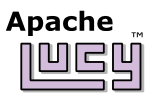NAME
Lucy::Docs::DevGuide - Quick-start guide to hacking on Apache Lucy.
DESCRIPTION
The Apache Lucy code base is organized into roughly four layers:
- Charmonizer - compiler and OS configuration probing.
- Clownfish - header files.
- C - implementation files.
- Host - binding language.
Charmonizer is a configuration prober which writes a single header file, “charmony.h”, describing the build environment and facilitating cross-platform development. It’s similar to Autoconf or Metaconfig, but written in pure C.
The “.cfh” files within the Lucy core are Clownfish header files. Clownfish is a purpose-built, declaration-only language which superimposes a single-inheritance object model on top of C which is specifically designed to co-exist happily with variety of “host” languages and to allow limited run-time dynamic subclassing. For more information see the Clownfish docs, but if there’s one thing you should know about Clownfish OO before you start hacking, it’s that method calls are differentiated from functions by capitalization:
Indexer_Add_Doc <-- Method, typically uses dynamic dispatch. Indexer_add_doc <-- Function, always a direct invocation.
The C files within the Lucy core are where most of Lucy’s low-level functionality lies. They implement the interface defined by the Clownfish header files.
The C core is intentionally left incomplete, however; to be usable, it must be bound to a “host” language. (In this context, even C is considered a “host” which must implement the missing pieces and be “bound” to the core.) Some of the binding code is autogenerated by Clownfish on a spec customized for each language. Other pieces are hand-coded in either C (using the host’s C API) or the host language itself.
Copyright © 2010-2015 The Apache Software Foundation, Licensed under the
Apache License, Version 2.0.
Apache Lucy, Lucy, Apache, the Apache feather logo, and the Apache Lucy project logo are trademarks of The
Apache Software Foundation. All other marks mentioned may be trademarks or registered trademarks of their
respective owners.
